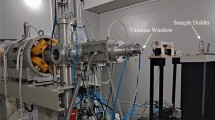Abstract
Irradiation by low-energy products leads to a variation in the electrical, optical, and other properties of the surface layer of semiconductor structures, which gives additional possibilities to modify semiconductor devices. This work is devoted to investigating the influence of radiation defects induced by low-energy protons at a sample temperature of 83 K on the properties of double-sided silicon photoelectric structures with a diffusion n+–p junction. Samples of the n+–p–p+ type are irradiated by a proton flux with a dose of 1015 cm–2 and energy of 40 or 180 keV. To explain the observed regularities of varying the parameters of the current–voltage characteristics and transmission coefficients, the distribution of the average number of interstitial silicon, vacancies, divacancies, and disordered regions formed under these conditions per length unit of the projected path by one proton in the diffusion layer in the space-charge region of the n+–p junction is calculated. It is shown that protons with an initial energy of 40 keV preferentially vary the physical properties of the layer with a high concentration of donors, while protons with an initial energy of 180 keV vary the properties of the space-charge region in the layer containing acceptors. The number of radiation-induced defects at the maximum of the spatial distribution in the n-type region is much smaller than in the p-type region.



Similar content being viewed by others
REFERENCES
M. Paulescu, D. Vizman, M. Lascu, R. Negrila, and M. Stef, AIP Conf. Proc. 1796, 040010 (2017).
S. Park, J. C. Bourgoin, H. Sim, et al., Progr. Photovolt. Res. Appl. 26, 778 (2018).
O. A. Oraby, M. F. El-Kordy, H. T. El-Madany, et al., Int. J. Sci., Eng. Technol. Res. 3, 173 (2014).
P. A. Iles, Sol. Energy Mater. Sol. Cells 68, 1 (2001).
V. A. Kozlov and V. V. Kozlovskii, Semiconductors 35, 735 (2001).
V. V. Kozlovski, A. A. Lebedev, V. V. Emtsev, et al., Nucl. Instrum. Methods Phys. Res., Sect. B 384, 100 (2016).
V. V. Kozlovski, A. E. Vasil’ev, and A. A. Lebedev, J. Surf. Invest.: X-ray, Synchrotr. Neutron Tech. 10, 693 (2016).
Y. A. Agafonov, N. M. Bogatov, L. R. Grigorian, et al., J. Surf. Invest.: X-ray, Synchrotr. Neutron Tech. 12, 499 (2018).
H. N. Yeritsyan, A. A. Sahakyan, N. E. Grigoryan, et al., J. Mod. Phys. 6, 1270 (2015).
T. Pagava and L. Chkhartishvili, Nano Res. Appl. 3, 1 (2017).
I. Pintilie, L. C. Nistor, S. V. Nistor, et al., in Proceedings of the Science 25th International Workshop on Vertex Detectors, Sept. 26–30,2016, Isola d’Elba, Italy, p. 033.
N. M. Bogatov, Poverkhnost’, No. 8, 66 (1999).
N. M. Bogatov and M. S. Kovalenko, AASCIT J. Phys. 3, 13 (2017).
N. M. Bogatov, L. R. Grigor’yan, A. V. Klenevskii, et al., Ekol. Vestn. Nauch. Tsentr. Chernomor. Ekon. Sotrudn. 16, 59 (2019).
A. L. Fahrenburch and R. H. Bube, Fundamentals of Solar Cells. Photovoltaic Solar Energy Conversion (Academic, New York, 1983; Energoatomizdat, Moscow, 1987).
ACKNOWLEDGMENTS
We thank Yu.A. Agafonov and V.I. Zinenko, colleagues at the Institute of Microelectronics Technology Problems and High-Purity Materials, Russian Academy of Sciences, for irradiation of the samples.
Funding
The study was performed according to the state order of the Southern Scientific Center of the Russian Academy of Sciences for the year 2019, number of state registration of the project 01201354240.
Author information
Authors and Affiliations
Corresponding author
Ethics declarations
The authors declare that they have no conflict of interest.
Additional information
Translated by N. Korovin
Rights and permissions
About this article
Cite this article
Bogatov, N.M., Grigorian, L.R., Kovalenko, A.I. et al. Influence of Radiation Defects Induced by Low-Energy Protons at a Temperature of 83 K on the Characteristics of Silicon Photoelectric Structures. Semiconductors 54, 196–200 (2020). https://doi.org/10.1134/S1063782620020062
Received:
Revised:
Accepted:
Published:
Issue Date:
DOI: https://doi.org/10.1134/S1063782620020062



